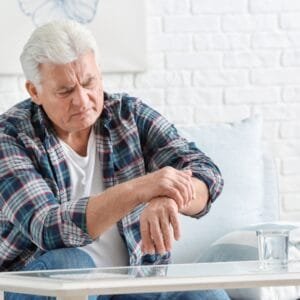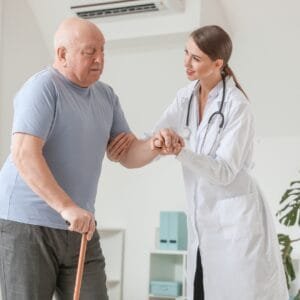Parkinson’s Disease: Causes, Symptoms, and Treatment
Parkinson’s disease (PD) is a progressive neurological disorder that affects movement and is caused by the degeneration of nerve cells in the brain. It primarily impacts motor skills, but as the disease progresses, it can also affect mood, behavior, and cognitive functions. Although there is no cure, early diagnosis and treatment can help manage symptoms and improve quality of life.



What is Parkinson’s Disease?
Parkinson’s disease occurs when the dopaminergic neurons in the substantia nigra, a part of the brain responsible for movement control, become damaged or die. These neurons produce dopamine, a chemical messenger essential for smooth, coordinated muscle movements. The decline in dopamine levels leads to the characteristic symptoms of Parkinson’s disease, such as tremors and stiffness.
PD is classified as a movement disorder, but it can also involve non-motor symptoms such as depression and cognitive decline.
Causes of Parkinson’s Disease
The exact cause of Parkinson’s disease remains unknown, but researchers believe it results from a combination of genetic, environmental, and lifestyle factors:
- Genetic Factors:
- Mutations in genes like LRRK2, PARK7, PINK1, and SNCA increase the risk.
- Family history plays a role in some cases, but most instances of PD are not inherited.
- Environmental Factors:
- Exposure to toxins like pesticides or herbicides.
- Heavy metal poisoning (e.g., manganese) or industrial chemicals.
- Aging:
- The risk of Parkinson’s increases with age, particularly after 60.
- Brain Inflammation:
- Chronic neuroinflammation may contribute to the degeneration of neurons.
Symptoms of Parkinson’s Disease
Parkinson’s symptoms are typically categorized as motor and non-motor:
Motor Symptoms
- Tremors: Shaking, usually in the hands or fingers, that occurs at rest.
- Bradykinesia: Slowness of movement, making everyday tasks difficult.
- Rigidity: Muscle stiffness that limits range of motion and causes pain.
- Postural Instability: Balance problems leading to frequent falls.
- Freezing of Gait: Sudden, temporary inability to move while walking.
Non-Motor Symptoms
- Depression and Anxiety: Emotional disturbances are common in PD patients.
- Cognitive Impairment: Difficulty with memory, attention, or problem-solving.
- Sleep Disorders: Insomnia, REM sleep behavior disorder, or excessive daytime sleepiness.
- Autonomic Dysfunction: Problems with blood pressure, digestion, and bladder control.
- Loss of Smell (Anosmia): Often an early symptom of Parkinson’s.
Diagnosis of Parkinson’s Disease
There is no specific test to definitively diagnose Parkinson’s disease. Diagnosis is typically based on a combination of:
- Medical History: Evaluation of symptoms and family history.
- Neurological Examination: Tests for tremors, stiffness, balance, and coordination.
- Imaging Tests:
- Response to Dopaminergic Medications: Improvement with drugs like levodopa suggests Parkinson’s disease.
Stages of Parkinson’s Disease
Parkinson’s disease progresses in five stages:
- Stage 1: Mild symptoms that do not interfere with daily activities; tremors may be present on one side.
- Stage 2: Symptoms appear on both sides, with slight difficulty in walking or maintaining posture.
- Stage 3: Balance issues and significant movement impairment.
- Stage 4: Severe disability; requires assistance for most activities.
- Stage 5: Complete dependence on others; difficulty standing or walking.
Treatment Options for Parkinson’s Disease
Although there is no cure for Parkinson’s disease, treatments focus on managing symptoms and improving quality of life:
Medications
- Levodopa-Carbidopa:
- The most effective treatment for motor symptoms.
- Levodopa converts to dopamine in the brain, while carbidopa prevents its breakdown.
- Dopamine Agonists:
- Mimic dopamine effects (e.g., pramipexole, ropinirole).
- MAO-B Inhibitors:
- Reduce the breakdown of dopamine (e.g., selegiline, rasagiline).
- COMT Inhibitors:
- Prolong the effect of levodopa (e.g., entacapone).
- Anticholinergics:
- Help reduce tremors and muscle stiffness.
Surgical Treatment
- Deep Brain Stimulation (DBS):
- Electrodes are implanted in specific brain regions to regulate abnormal activity.
- Effective for advanced Parkinson’s with severe motor symptoms.
Therapies
- Physical Therapy:
- Improves mobility, flexibility, and balance.
- Occupational Therapy:
- Helps with daily tasks and maintaining independence.
- Speech Therapy:
- Addresses communication and swallowing difficulties.
- Cognitive Behavioral Therapy (CBT):
- Helps manage depression and anxiety.
Lifestyle Adjustments for Parkinson’s Disease
- Exercise Regularly:
- Activities like walking, yoga, or tai chi can improve mobility and balance.
- Healthy Diet:
- Eat a diet rich in fruits, vegetables, whole grains, and omega-3 fatty acids to support brain health.
- Sleep Hygiene:
- Maintain a consistent sleep schedule and avoid stimulants before bedtime.
- Stress Management:
- Practice relaxation techniques like meditation or deep breathing.
Complications of Parkinson’s Disease
Without proper management, Parkinson’s disease can lead to complications such as:
- Dysphagia: Difficulty swallowing, increasing the risk of aspiration pneumonia.
- Dementia: Cognitive decline in advanced stages.
- Infections: Weakened immune response may lead to frequent infections.
- Depression and Isolation: Resulting from limited mobility and social interactions.
- Falls and Injuries: Due to balance and coordination issues.
Preventing Parkinson’s Disease
While Parkinson’s cannot always be prevented, these measures may reduce the risk or delay onset:
- Regular Exercise: Promotes brain health and reduces inflammation.
- Healthy Diet: Rich in antioxidants, vitamins, and omega-3 fatty acids.
- Avoid Toxins: Minimize exposure to pesticides, herbicides, and industrial chemicals.
- Protect Brain Health: Wear helmets during activities that risk head injuries.
- Stay Mentally Active: Engage in activities like puzzles, reading, or learning new skills.
FAQs about Parkinson’s Disease
1. What causes Parkinson’s disease?
Parkinson’s is caused by the degeneration of dopamine-producing neurons in the brain, influenced by genetic and environmental factors.
2. What are the early symptoms of Parkinson’s disease?
Early symptoms include tremors, slowness of movement, muscle stiffness, and loss of smell.
3. Is Parkinson’s disease curable?
There is no cure, but treatments like medications and therapies can effectively manage symptoms.
4. How is Parkinson’s diagnosed?
Diagnosis is based on medical history, neurological exams, and response to dopaminergic medications.
5. What is the role of exercise in Parkinson’s management?
Exercise improves mobility, balance, and overall quality of life while slowing disease progression.
Conclusion
Parkinson’s disease is a complex and progressive neurological disorder, but advancements in treatments and therapies have greatly improved symptom management. By combining medical care, therapies, and lifestyle adjustments, individuals with Parkinson’s can lead fulfilling lives. Early diagnosis and proactive management are crucial in slowing disease progression and maintaining independence.
